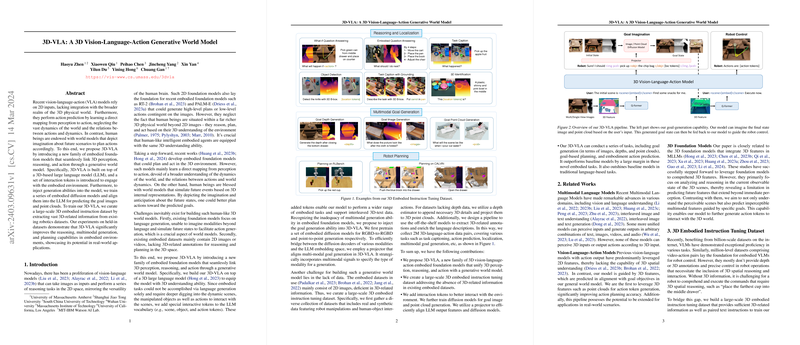3D-VLA: Bridging 3D Perception, Reasoning, and Action through Generative World Modeling
Introduction to 3D-VLA
Existing embodied AI models predominantly navigate and interact with environments through 2D sensory inputs, lacking in a comprehensive 3D spatial understanding. Such models typically learn a direct action-from-perception mapping, which overlooks the nuanced dynamics of real-world interactions. In contrast, humans rely on a rich 3D conceptualization of their surroundings to forecast future scenarios and plan actions accordingly. Addressing this gap, the paper introduces 3D-VLA, a novel embodied foundation model that unifies 3D understanding, reasoning, and action within a generative world model framework. This model is distinctive in its integration of 3D perception with language and action prediction capabilities, facilitated by a specially curated large-scale 3D embodied instruction dataset.
Key Contributions
The paper makes several significant contributions to the field of 3D embodied AI and generative modeling:
- 3D-VLA Architecture: A new model that integrates 3D perception with reasoning and action, underpinned by a 3D-based LLM and enriched through interaction tokens for comprehensive environmental engagement.
- 3D Embodied Instruction Tuning Dataset: To overcome the lack of 3D data, the researchers curated a novel dataset with extensive 3D-related annotations, contributing to the model's training and performance.
- Enhanced Multimodal Generative Abilities: Through pretraining a series of embodied diffusion models and aligning them with the LLM via a specialized projector, the model boasts enhanced goal-generation capabilities.
- Benchmark Performance: Empirical evaluations demonstrate 3D-VLA's superiority in tasks such as reasoning, multimodal generation, and planning within embodied environments, displaying significant advancements over baseline models.
Technical Overview
Model Architecture
At its core, 3D-VLA operates atop a 3D-oriented LLM, leveraging interaction tokens to foster environment engagement. The model's training involves aligning embodied diffusion models with the LLM to enable predictive generation of goal states in various modalities (images and point clouds).
Data Curation
Facing a scarcity of suitable 3D data for training, the researchers developed a novel dataset encompassing 2M 3D-language-action data pairs. This dataset amalgamates information from diverse sources, including robotics and human-object interaction, augmented with depth estimation and 3D annotation extraction.
Capabilities
The model distinguishes itself through its multifaceted capabilities: It interprets 3D scenes, performs reasoning tasks, generates multimodal goal states, and predicts actions for robot manipulation - all while achieving impressive benchmarks against conventional models.
Practical Implications and Theoretical Advancements
3D-VLA represents a significant stride towards models that can seamlessly navigate and interact with their environments in a manner more akin to human cognitive processes. It highlights the pivotal role of 3D perception and generative world modeling in crafting more intelligent, aware, and capable AI agents that can anticipate and act in complex, dynamic settings.
Speculations on Future Directions
The introduction of 3D-VLA paves the way for exciting future developments in AI. It opens avenues for exploring more intricate interaction dynamics, enhancing real-world applicability, and pushing the boundaries of what AI can perceive and achieve in three-dimensional spaces. Further research may delve into refining these models for specific real-world applications, improving efficiency, and expanding their understanding and generative capabilities.
In conclusion, 3D-VLA marks a noteworthy advancement in the pursuit of more holistic AI systems capable of understanding and interacting with the world in all its three-dimensional complexity. Through innovative architectural choices, strategic data curation, and multifaceted capabilities, it sets a new benchmark for future research and applications in the field of 3D embodied AI.
